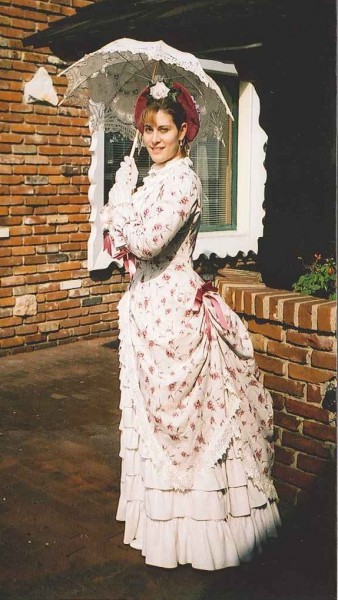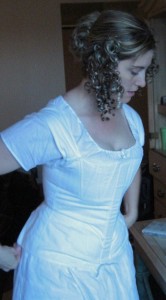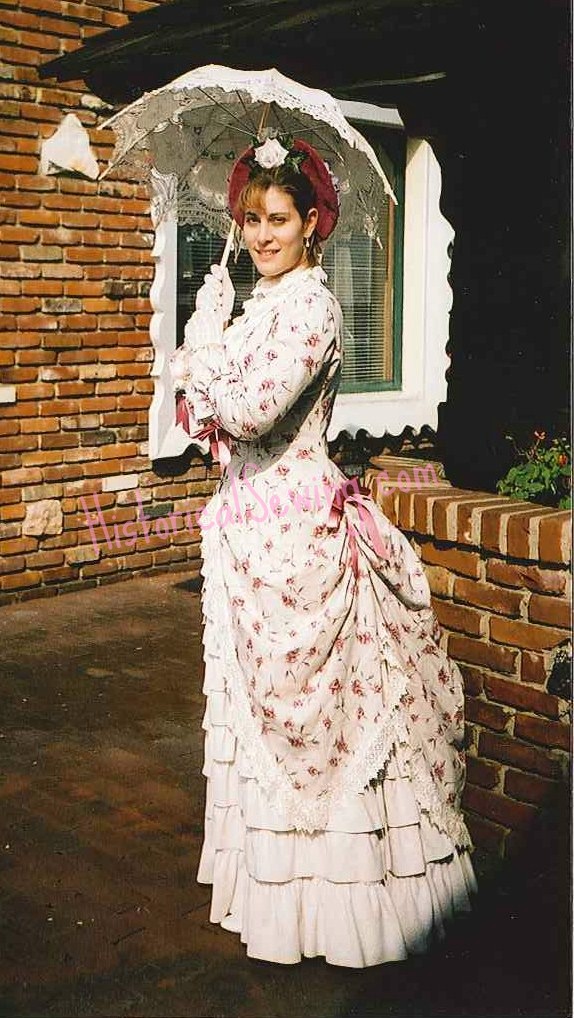
I think linen is lovely even though I don’t use it much.
I’ve had to almost force myself to sew with it. But why? My very first truly historical costume (not counting that blue velvet Italian Renaissance gown or any other Halloween stuff) was an 1880 polonaise courtesy of Past Patterns. You know the pattern.
Well, guess what? I used a linen/rayon fabric for the skirt ruffles and a linen blend for the polonaise. And it looks great! I love that rose print fabric and would totally use it again in another bustle project. So why do I shy away from using linen?
I guess that might’ve come from my research of Victorian undergarments that revealed that most chemises & drawers were made of cotton. Well, that’s not entirely accurate even if it appears that way because of what has survived now. But linen was used too.
Or maybe I stay away because of those horrible creases that occur due to the nature of the flax fibers. Some wrinkles just never come out no matter how hard you press with a HOT iron. It’s just the nature of linen. And despite the enormous amount of time I spend pressing I don’t want a costume that requires that much upkeep time.
My next use of linen in costumes was in my medieval/fantasy gown for Costume College 2005. I used a very nice cranberry linen that actually turned my armpits pink. Yikes! Guess I should have washed it two or three times to bleed it all out.

Then as I progressed in my 19th Century sewing, I decided to make a linen shift for my Regency costumes. I LOVED it! Oh my gosh! I have to make more undergarments out of lightweight linen.

So despite sewing only a handful of items (there are more than what’s listed here!), I have picked up some good tips that I’m sure to use when I work again with linen. Apply them to your next project too.
*Linen MUST be pre-washed, even multiple times, to shrink the fabric piece as much as possible. Wash in warm or even hot water. Use low heat to dry or lay out to air dry. Hanging in the sun on a clothesline is a marvelous way to dry linen. (Just wish I had a line in my yard.)
*Press when still damp or use a spray bottle with water to dampen then press with a hot steam iron. You will save SO much time if you dampen the linen first before pressing. Yes.
*Linen is a delight to use as an underlining in bodices, especially for summer wear. It works really well for sheer dresses too. 😉
*Linen comes in various weights (listed in ounces (oz.)). The smaller the number (2.5), the lighter the weight. A 5.5 can be fairly stiff and thick – good for under-petticoats and cool weather bodice underlinings.
*Higher quality linen will have very few slubs (bulky sections of thread fibers within the weaving).
*Handkerchief linen is the lightweight stuff you would make a handkerchief out of. Common sense would tell us that something you wipe your nose, eyes and face with would not be a heavy, scratchy thing. I have a couple of mid-20th Century handkerchiefs made from linen and embroidered and they are the airy-est of items.
*When making a costume for a poor impression, go for the heavier stuff in darker colors.
*Black linen is not really black but a charcoal or gray-black. If you find a dark black (oxymoron, I know) snag it! But be aware the color is not fast and will bleed and lighten with washing.
*The more you wash, the softer it gets.
*It sews like cotton. It breathes like cotton. It’s snuggly (after lots of washing of course).
Update, January 2014: I was recently told to soak linen before pre-washing in the washer before cutting. This helps to soften the plant fibers so they don’t get permanent creases when dealing with the fabric later in the making and wearing of it. This post on washing linen was shared. It was so insightful that I wanted to pass it on to you.
Below are a few online sources I found that sell linen. I have not purchased from all of them so remember buyer beware. If you have another place you love, please post a comment to share with us.
Fabric-Store.com – wonderful linen textiles
Renaissance Fabrics – Tell Diana you found her here!
Burnley & Trowbridge – Tell Angela you found her here!


I love working with and wearing linen, especially for my everyday skirts. My Grandma taught me to soak my new fabric in water with a cup or two of vinegar mixed in before washing it. This helps to “set” the color so it doesn’t fade or wash out as much. I’ve regretted it when I didn’t do it on dark colors. I do the same thing with new jeans. Hope this helps.
Absolutely good tip! A few years ago (well after writing this post) I was recommended to soak my linen first before a full machine wash. It came out so lovely. Thanks for your comment!
I am going to make the 1830-40 corset and chemise and saw them on in your article on linen. I certainly will consider linen instead of cotton for this set of undergarments. Thanks
Sorry, forgot to mention that she puts the linen or cotton garments in a plastic bag then refrigerated it for a few hours then ironed. Of course, this is the same woman although a busy business woman who irons her high quality cotton sheets because she says it makes them softer.
Another company I bought handkerchief linen was from Pure Silks out of India…I was buying the silk for my wedding dress and ordered a yard of their lightest weight…it is almost transparent with very few slubs…looks like I could do drawn work on it. I only washed it once because I am saving it for collars and cuffs so is still a bit stiff…will wash it again later. About ironing linen, my mother always sprinkled hers with water and then refrigerated it for a few hours…or froze it if she was in a hurry…she also treated hard to iron cotton this way…it always turned out very crisp and did not seem to wrinkle back up badly, even in Florida’s famous humidity.
I’ve never bought linen from Pure Silks – only organdy and silk. Thanks for the comment on it!
I very recently learned that freezing or refrigerating fabrics will cause the fibers to break down faster. Yes, it may help with ironing and wrinkles but not so good if you want the garment to last. Starching would help more than freezing. But I don’t speak of much experience on freezing fabrics….
One of the reasons that linen is wonderful for undergarments in hot climates is that it drys faster than cotton. One of the reasons cotton became so popular was because of the short route from plant to fabric. Linen requires several processes before the fiber is ready to be spun.
I adore linen. It’s the most comfortable next-to-skin layer I’ve ever found. The way it wrinkles if you so much as twitch doesn’t matter so much for chemises, though yeah, it is a nuisance in outer garments. It’s worth the ironing, though!
I highly recommend http://www.dharmatrading.com for good-quality plain white linen at quite a good price–actually, all the fabric I’ve had from there (linen, silk and cotton so far) has been excellent. They generally only have plain white, or sometimes plain black, cloth, but they sell dyes if you’re feeling adventurous. 🙂
My grandmother taught me how to sprinkle linens to iron. She had a specific bottle with sprinkle top that she used distilled water only for. Lay out the item, sprinkle it, roll it in tea towels, then set aside while the towel absorbs the excess moisture. When the item is just damp to the touch, iron with a hot iron set to the linen setting. I have always thought this would be an interesting “home task” for an impression but who wants to build the fire to heat the iron, etc…. However, this process is why women had an ironing day – it took quite a while and had a variety of steps. Plus there is the smell of crisp ironed linen that I have always loved. 🙂
That would be a great impression! You could spend all day in camp just ironing.
So true too, linen takes time to absorb the water/moisture. Letting it sit is the perfect way to hammer out those wrinkles. (I think starch would help too.)
I second the motion of wetting linen and then ironing it dry. Worked like a charm on some little antique linen coaster doilies I washed. I’ve found this to also work on coutil that I have machine washed and put in the dryer– the wrinkles just would not iron out until I wetted it first, then it was fine.
So my first ren nobles I had made in linen because I play in the California Central Valley for the most part. I feel for all the people who wear any other fabrics. While I might be a little wrinkled, I was cooler than they were and I always told people wrinkles were period. 🙂
I love Fabric-Store.com I have been very happy with all my fabric from there.